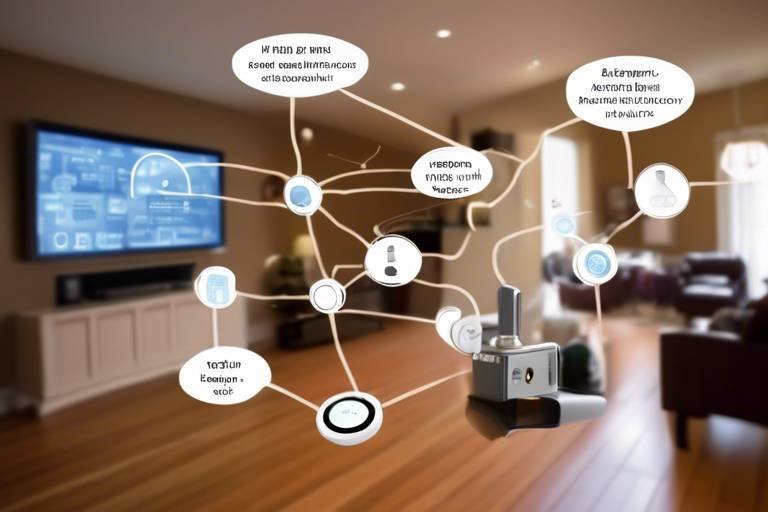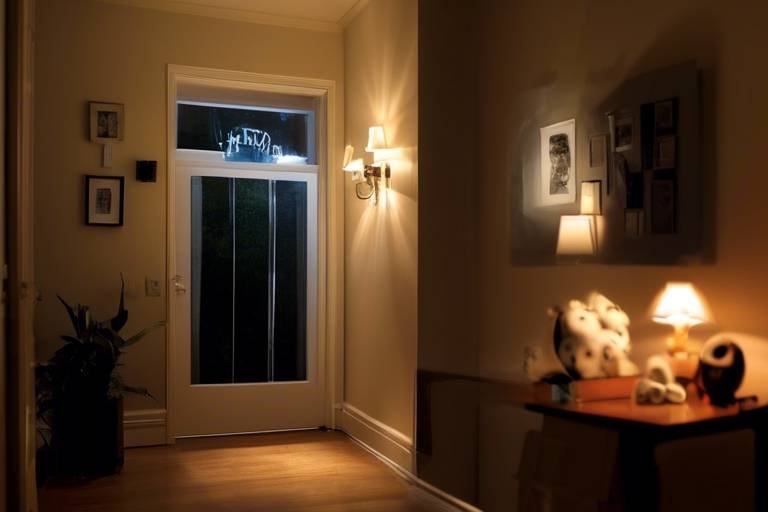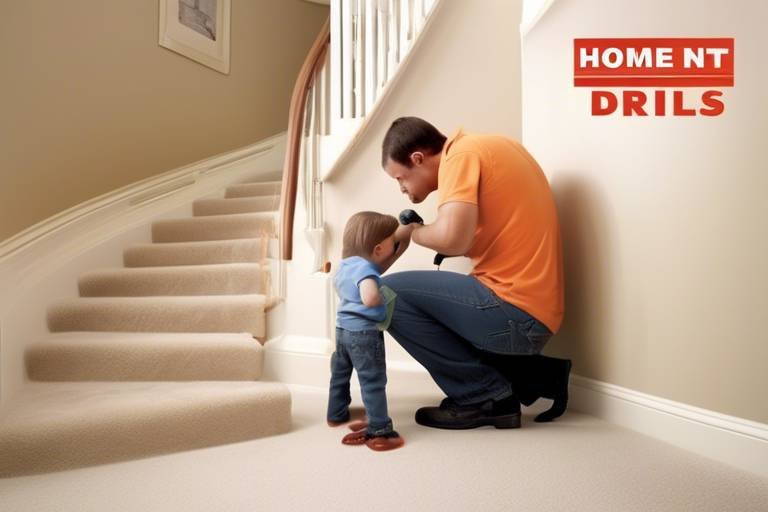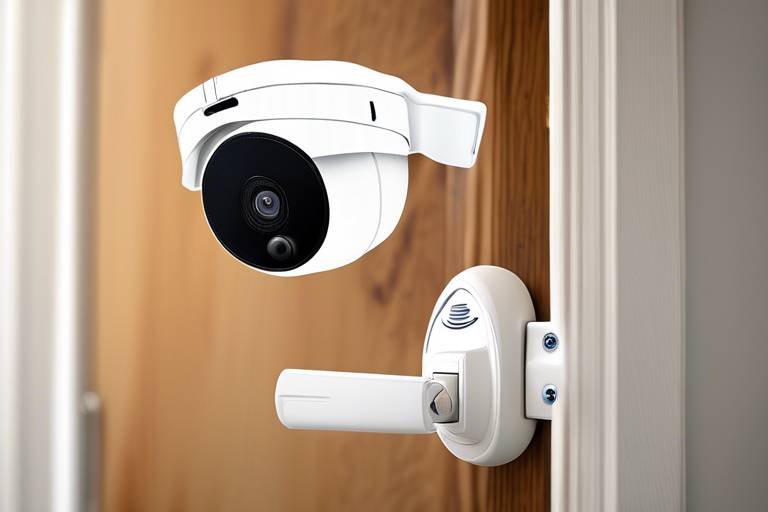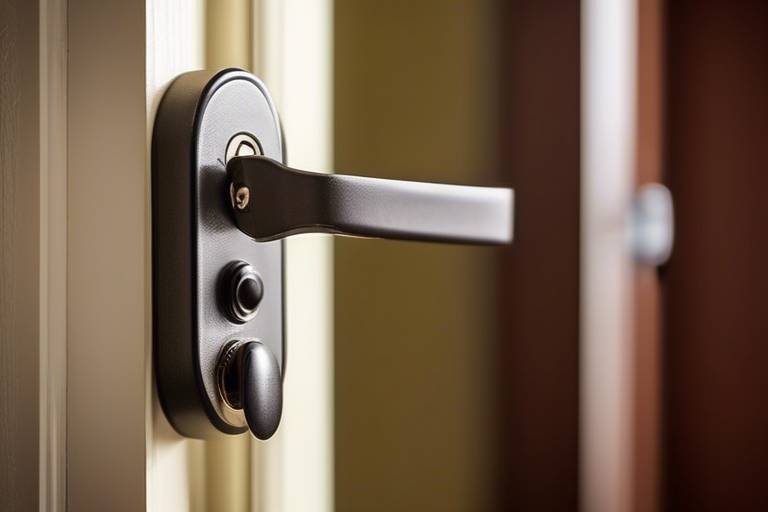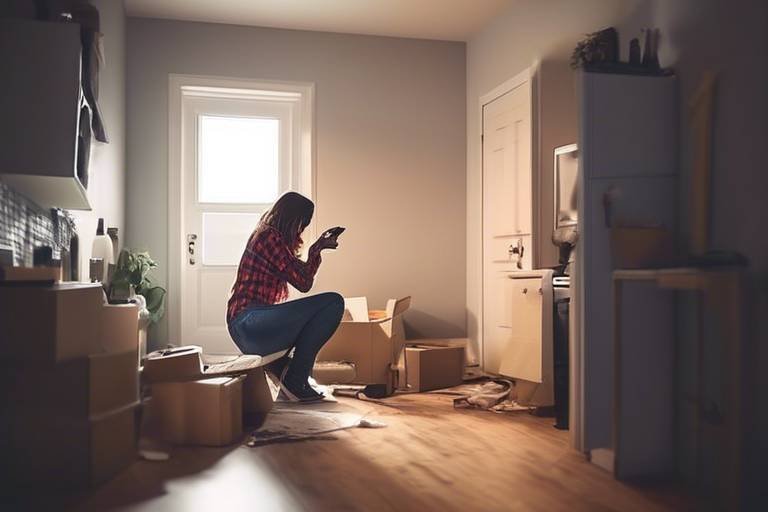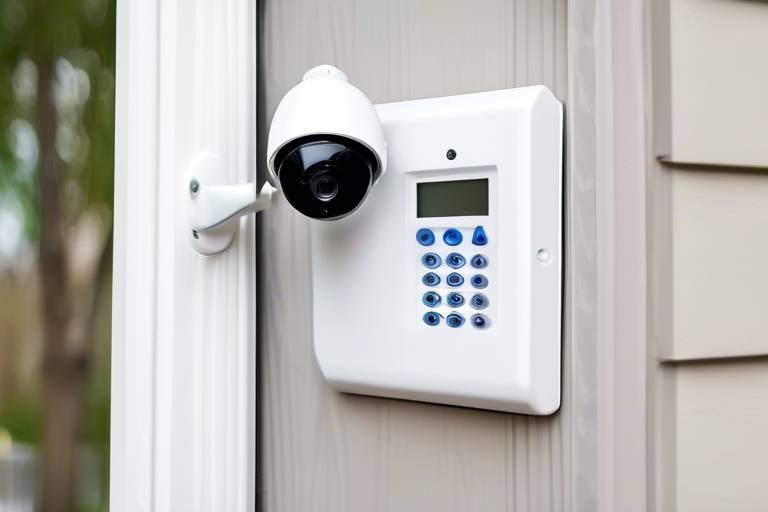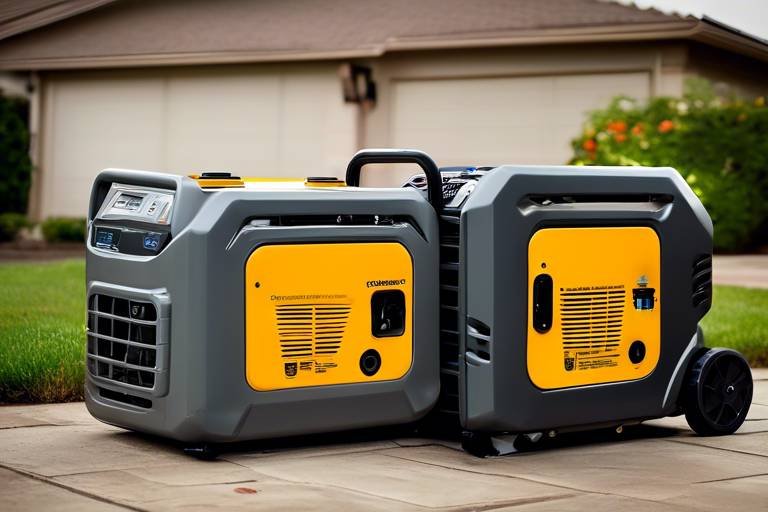Can Home Automation Offer Better Security
In today's fast-paced world, the quest for safety and security has taken on new dimensions. With the rise of technology, homeowners are increasingly turning to home automation systems as a means to bolster their security measures. But can these systems really offer better protection? The answer is a resounding yes! Home automation not only simplifies our lives but also enhances our security in ways we never thought possible. Imagine being able to monitor your home from anywhere in the world, or receiving instant alerts when something unusual is detected. This article will explore the various technologies that contribute to a secure home environment, highlighting their benefits and how they can be seamlessly integrated into your daily routine.
Home automation has transformed the way we interact with our living spaces. Gone are the days when security meant just a simple lock and key. Today, smart home technology is revolutionizing our homes, making them more efficient and secure. The evolution of this technology has been nothing short of astounding. Initially, home automation focused on energy efficiency and convenience, but it has now expanded to include robust security features. As more people recognize the importance of protecting their homes, the demand for smart security solutions continues to grow. This shift is not just a trend; it's a reflection of our changing lifestyles and the increasing need for peace of mind.
Home automation systems are equipped with a plethora of security features that work together to create a safer living environment. These features include smart cameras, motion sensors, and alarms, all designed to keep intruders at bay and provide homeowners with peace of mind. Each component plays a crucial role in the overall security strategy, and when integrated effectively, they can turn your home into a fortress. Let's take a closer look at some of these essential components.
Smart cameras are the eyes of your home security system. They provide real-time monitoring, motion detection, and remote access, making them an invaluable tool for homeowners. Imagine being able to check on your property from your smartphone while you're on vacation. With smart cameras, this is a reality. They allow you to view live feeds, receive alerts when motion is detected, and even communicate with visitors at your door. The technology behind these cameras has advanced significantly, offering features like night vision and high-definition recording. This not only enhances your security but also gives you a sense of control over your environment.
One of the standout features of smart cameras is their ability to integrate with mobile devices. This integration allows homeowners to monitor their property from virtually anywhere. Whether you're at work, on vacation, or simply running errands, you can access your camera feeds through a mobile app. This level of accessibility means you're always connected to your home, providing an extra layer of reassurance. Imagine receiving a notification while at a restaurant that someone is at your front door; you can check the live feed and decide whether to answer or not, all from your phone!
Facial recognition technology is another remarkable feature found in many smart cameras today. This technology not only identifies familiar faces but also alerts homeowners to the presence of strangers. By analyzing facial features, these cameras can distinguish between family members, friends, and potential intruders. This added layer of security helps ensure that you are aware of who is coming and going from your home, enhancing your overall safety.
Motion sensors are essential for detecting unusual activity around your home. These devices can be placed both indoors and outdoors, ensuring comprehensive coverage. When motion is detected, homeowners receive immediate alerts, allowing them to respond quickly to potential threats. There are various types of motion sensors, including passive infrared sensors, which detect heat emitted by bodies, and video motion detection, which analyzes video feeds for movement. The effectiveness of these sensors can significantly reduce the risk of break-ins and increase your sense of security.
Smart locks are another exciting development in home automation that offers enhanced security and convenience. These locks operate digitally, allowing homeowners to control access to their homes through smartphones or keypads. With features like remote access control and temporary access codes, smart locks provide a seamless way to manage who enters your home.
Remote access control is a game-changer for homeowners. It allows you to lock or unlock your doors from anywhere, providing peace of mind when you're away from home. Imagine being able to let a friend in while you're at work or ensuring that the door is locked after you leave. This feature not only enhances security but also adds a layer of convenience to your daily life.
Temporary access codes are another fantastic feature of smart locks. Homeowners can generate unique codes for guests or service providers, ensuring that they have access without compromising security. Once the visit is over, these codes can be easily deactivated, maintaining control over who can enter your home. This flexibility is particularly useful for people who frequently have visitors or service personnel, allowing for a secure yet accommodating environment.
Despite the numerous advantages of home automation systems, it's essential to be aware of potential challenges. Security vulnerabilities, such as hacking and system malfunctions, can pose risks if not addressed properly. Homeowners should consider the importance of choosing reputable brands, keeping software updated, and implementing strong passwords to safeguard their systems. Additionally, while the convenience of smart technology is appealing, it's crucial to balance this with privacy concerns. As we embrace the future of home automation, staying informed and vigilant is key to ensuring a secure home environment.
- Can I integrate home automation with my existing security system? Yes, many home automation systems are designed to work alongside existing security measures, allowing for a comprehensive approach to home safety.
- Are smart cameras always recording? Most smart cameras have the option to record continuously or only when motion is detected, depending on your preferences.
- How secure are smart locks? Smart locks utilize encryption and other security measures to protect against unauthorized access, but it's essential to choose reputable brands and follow best practices for security.
- What happens if the power goes out? Many home automation systems have backup battery options, ensuring that your security features remain operational even during power outages.

The Rise of Home Automation
Home automation has revolutionized the way we interact with our living spaces, transforming them into smart environments that cater to our needs and enhance our security. Imagine a home that not only responds to your commands but also anticipates your needs—sounds futuristic, right? Well, that future is now! Over the past decade, we've witnessed a remarkable evolution in smart home technology, driven by advancements in the Internet of Things (IoT), artificial intelligence (AI), and cloud computing.
Initially, home automation was a luxury reserved for the tech-savvy elite, but today, it has become accessible to the average homeowner. With the proliferation of affordable smart devices, such as smart bulbs, thermostats, and security systems, more people are embracing the convenience and security that these technologies offer. According to recent studies, the global home automation market is projected to grow from $80 billion in 2021 to over $150 billion by 2026, showcasing a clear trend towards smarter living.
One of the primary reasons for this surge in popularity is the increasing concern for home security. Traditional security systems often fall short, leaving homeowners feeling vulnerable. However, home automation systems provide a comprehensive approach to security, integrating various technologies to create a cohesive and responsive environment. For instance, a smart home can utilize sensors, cameras, and alarms that communicate with each other, offering real-time alerts and remote monitoring capabilities.
Moreover, the integration of smart devices into our daily lives has made managing home security easier than ever. With just a few taps on a smartphone app, homeowners can control their security systems, receive notifications, and even view live feeds from their cameras. This level of accessibility not only enhances security but also fosters peace of mind, allowing homeowners to feel more in control of their environment.
As we continue to embrace this technological evolution, it's essential to recognize the role that home automation plays in enhancing our security measures. The convenience and efficiency of these systems are paving the way for a safer future, making them an invaluable addition to any home. So, whether you're a tech enthusiast or simply looking to bolster your home's security, investing in home automation is a step in the right direction.

Key Security Features of Home Automation
Home automation systems are revolutionizing the way we think about security in our living spaces. With the advent of smart technology, homeowners now have access to a suite of advanced features designed to enhance safety and provide peace of mind. From smart cameras to motion sensors, these systems are equipped with tools that can detect, alert, and even respond to security threats in real time. Imagine being able to monitor your home from anywhere in the world, or receiving instant notifications if something seems amiss. This is the power of home automation!
One of the most significant components of these systems is smart cameras. These devices not only record video footage but also offer functionalities such as real-time monitoring and motion detection. With capabilities like night vision and cloud storage, homeowners can review footage at their convenience, ensuring that nothing goes unnoticed. The integration of smart cameras with mobile devices further enhances their utility, allowing users to check in on their property anytime, anywhere. Imagine being on vacation and receiving a notification on your phone about unexpected movement in your yard—this feature can be a game changer!
In addition to smart cameras, motion sensors are another essential feature of home automation systems. These sensors can be placed around the perimeter of your home or within its interior to detect unusual activity. When motion is detected, the system can trigger alarms or send alerts directly to your smartphone. This proactive approach means that homeowners can respond to potential threats before they escalate. Depending on the technology used, motion sensors can differentiate between pets, people, and even vehicles, reducing false alarms and ensuring that alerts are meaningful.
Moreover, the integration of facial recognition technology in smart cameras is a cutting-edge feature that significantly boosts home security. This technology can identify familiar faces and alert homeowners if an unknown individual is detected on their property. It’s like having a personal security guard who knows who belongs and who doesn’t! This feature not only enhances security but also provides a sense of familiarity and control over who enters your home.
To summarize, the key security features of home automation systems include:
- Smart Cameras: Real-time monitoring, motion detection, and remote access.
- Motion Sensors: Detection of unusual activity with alerts to homeowners.
- Facial Recognition: Identifying known individuals versus potential intruders.
Together, these features create a comprehensive security solution that is adaptable to the unique needs of each household. Home automation not only enhances security but also offers convenience and peace of mind, making it a worthy investment for any homeowner looking to protect their sanctuary.

Smart Cameras
When it comes to enhancing home security, are like the vigilant watchmen of your property. Imagine having a pair of eyes that never blink, constantly monitoring your surroundings. These devices have revolutionized the way we think about safety at home, offering features that go beyond traditional surveillance. With real-time monitoring, homeowners can keep an eye on their property from anywhere in the world, thanks to the power of the internet and mobile technology.
One of the standout functionalities of smart cameras is motion detection. This feature uses advanced algorithms to identify movement within the camera's field of view, sending instant alerts to your smartphone if anything unusual occurs. Picture this: you're on vacation, and your smart camera detects movement in your yard. You receive a notification, allowing you to check the live feed and assess the situation without having to rely on a neighbor or worry from afar. It’s like having a personal security guard available 24/7!
Moreover, the ability to access camera feeds remotely adds an unparalleled level of control. Homeowners can easily connect their smart cameras to mobile devices through dedicated apps. This integration means that whether you're at work, out for dinner, or on a beach holiday, you can monitor your home with just a few taps on your phone. This kind of accessibility is a game-changer, providing peace of mind and the assurance that your home is secure even when you're not physically present.
Another impressive feature is facial recognition technology, which takes smart cameras to the next level. This technology allows cameras to differentiate between familiar faces and strangers, sending alerts only when an unidentified individual is detected. Think of it as a personal bouncer for your home. If your camera recognizes your family members, it won’t bother you with notifications, but if it spots an unfamiliar face, you’ll be the first to know. This capability not only enhances security but also minimizes false alarms, making your home monitoring experience much more efficient.
In summary, smart cameras are an essential component of modern home security systems. They offer a blend of real-time monitoring, advanced motion detection, and facial recognition technology, all designed to keep your home safe and secure. Investing in these devices is like investing in your peace of mind, knowing that your home is under constant watch, even when you’re miles away.
- What are smart cameras? Smart cameras are advanced surveillance devices equipped with features like motion detection, remote access, and facial recognition, designed to enhance home security.
- How do I access my smart camera feed? You can access your smart camera feed through a mobile app that connects to the camera, allowing you to monitor your home from anywhere.
- Can smart cameras reduce false alarms? Yes, with features like facial recognition, smart cameras can differentiate between familiar faces and strangers, helping to minimize unnecessary alerts.

Integration with Mobile Devices
In today's fast-paced world, having the ability to control your home security from the palm of your hand is nothing short of revolutionary. The integration of home automation systems with mobile devices has transformed how homeowners interact with their security measures. Imagine being at work, sipping your coffee, and effortlessly checking your home cameras or locking your doors—all through a simple app on your smartphone. This level of convenience not only provides peace of mind but also enhances the overall security of your home.
Mobile apps designed for home automation systems offer a range of functionalities that empower homeowners. Through these applications, you can:
- Monitor Live Feeds: Access real-time video feeds from smart cameras, allowing you to keep an eye on your property no matter where you are.
- Receive Alerts: Get instant notifications if motion is detected or if a door is left unlocked, ensuring you stay informed about any unusual activities.
- Control Devices Remotely: Lock or unlock doors, turn lights on or off, and even adjust your thermostat—all from your mobile device.
Moreover, the user-friendly interfaces of these apps make it easy for anyone to navigate and utilize their features. Whether you're tech-savvy or not, you can quickly familiarize yourself with the functionalities available. This accessibility is crucial, especially in emergencies where every second counts. For instance, if you receive a notification of suspicious activity, you can immediately check your cameras and take action, whether that means contacting authorities or alerting neighbors.
Furthermore, many of these mobile applications allow for integration with voice assistants like Amazon Alexa or Google Assistant. This means you can simply use your voice to manage your home security. Picture this: after a long day, you arrive home, and instead of fumbling for keys, you just say, "Alexa, lock the front door." This not only adds a layer of convenience but also enhances security by reducing the chances of leaving doors unlocked.
In summary, the integration of home automation systems with mobile devices is a game-changer for home security. It offers unparalleled convenience, real-time monitoring, and immediate access to control your home environment. As technology continues to advance, the potential for even more sophisticated features will only increase, making our homes safer and our lives easier.
Q: Can I control my home security system while I’m away?
A: Yes! Most home automation systems allow you to monitor and control your security features remotely through a mobile app.
Q: What happens if my internet goes down?
A: Many systems have backup features or local storage options, but remote access may be limited without an internet connection.
Q: Is it safe to rely on mobile apps for home security?
A: While no system is entirely foolproof, reputable home automation systems utilize strong encryption and security protocols to protect your data.
Q: Can I integrate my existing security devices with new home automation technology?
A: Many modern home automation systems are designed to be compatible with a wide range of existing devices, but it’s best to check compatibility before purchasing.

Facial Recognition Technology
Facial recognition technology is one of the most exciting advancements in home security systems today. Imagine a world where your home knows you, recognizes your loved ones, and alerts you to any unfamiliar faces lurking around your property. This technology uses sophisticated algorithms to analyze facial features and match them against a database of known individuals. It’s like having a personal security guard who never sleeps and is always on the lookout for potential threats.
The integration of facial recognition into smart cameras not only enhances security but also provides homeowners with a sense of control and peace of mind. For instance, if someone approaches your front door, the camera can instantly identify whether it's a family member or a stranger. This enables you to take appropriate action, whether it’s welcoming your friend or alerting the authorities about an intruder. The technology learns and adapts over time, improving its accuracy and reducing false alarms.
However, while the benefits are significant, there are also important considerations to keep in mind. Privacy concerns often arise with the deployment of facial recognition technology. Homeowners must ensure that their systems are secure and that personal data is handled responsibly. It’s crucial to use systems that comply with local privacy regulations and to understand how your data is stored and used.
In addition, the effectiveness of facial recognition technology can be influenced by various factors, such as:
- Lighting Conditions: Poor lighting can hinder the camera's ability to accurately capture facial features.
- Camera Positioning: The angle and height of the camera can affect its ability to recognize faces.
- Database Size: A larger database can improve recognition rates but may also raise privacy concerns.
To summarize, facial recognition technology is a powerful tool in the realm of home security. Its ability to provide real-time alerts and enhance monitoring capabilities is unparalleled. However, as with any technology, it comes with its own set of challenges. Homeowners should weigh the benefits against privacy implications and ensure they are using reliable systems that prioritize security and data protection.

Motion Sensors
Motion sensors are an integral part of any home automation security system, acting as the vigilant eyes that watch over your property when you're not around. These devices are designed to detect unusual activity, alerting homeowners to potential threats before they escalate. Imagine a silent guardian, always on the lookout, ensuring your home remains a safe haven. The technology behind motion sensors can vary, but they typically operate using infrared signals, ultrasonic waves, or even video analysis to monitor movement within a designated area.
One of the most appealing aspects of motion sensors is their versatility. They can be installed both indoors and outdoors, making them perfect for monitoring everything from your front porch to your living room. When integrated into a home automation system, these sensors can trigger a series of actions to enhance security. For example, if a sensor detects movement in your yard during the night, it might activate outdoor lights, send an alert to your smartphone, or even start recording video footage. This not only helps to deter potential intruders but also provides peace of mind knowing that your home is being actively monitored.
There are several types of motion sensors available on the market, each with its own unique features and benefits:
- Passive Infrared Sensors (PIR): These sensors detect heat emitted by people and animals, making them ideal for outdoor use.
- Microwave Sensors: They emit microwave pulses and measure the reflection off moving objects, offering a wider detection range.
- Dual-Technology Sensors: Combining both infrared and microwave technologies, these sensors reduce false alarms while ensuring reliable detection.
The effectiveness of motion sensors can be significantly enhanced when paired with other home automation features. For instance, when a motion sensor detects movement, it can trigger a series of automated actions, such as locking doors, turning on lights, or notifying local authorities. This interconnectedness not only improves your home’s security but also creates a seamless living experience. However, it’s essential to position these sensors strategically to maximize their effectiveness and minimize false alarms caused by pets or passing vehicles.
In conclusion, motion sensors are a vital component of modern home security systems. They provide a proactive approach to safety, allowing homeowners to stay one step ahead of potential threats. By integrating motion sensors into your home automation setup, you can create a comprehensive security network that protects your home and gives you peace of mind.
Frequently Asked Questions
- How do motion sensors work? Motion sensors work by detecting changes in their environment, typically through infrared signals or sound waves, and alerting the homeowner of any unusual activity.
- Can motion sensors be used indoors? Yes, motion sensors can be effectively used indoors to monitor movement within your home, enhancing security in areas like hallways and entry points.
- Are there any limitations to motion sensors? Yes, while motion sensors are effective, they can sometimes trigger false alarms due to pets or environmental factors like wind or passing vehicles.

Benefits of Smart Locks
Smart locks are revolutionizing the way we think about home security. Gone are the days of fumbling for keys or worrying about lost duplicates. Instead, these innovative devices offer a blend of enhanced security and unmatched convenience. Imagine being able to lock or unlock your door with just a tap on your smartphone or even through voice commands! It’s like having a personal doorman at your beck and call, ready to grant access to friends or family whenever you need.
One of the standout features of smart locks is their remote access control. This means that whether you're at work, on vacation, or just lounging on the couch, you can easily manage who enters your home. For instance, if a delivery arrives while you're out, you can unlock the door for the courier and then lock it again once they’ve left. This level of control not only adds convenience but also significantly enhances your home’s security by allowing you to monitor access in real-time.
Another remarkable aspect of smart locks is the ability to generate temporary access codes. This feature is particularly useful for guests or service providers. Imagine having a friend over while you’re away, or needing to grant access to a cleaning service. Instead of handing out a physical key, you can create a unique code that works for a limited time. This way, you maintain control over who can enter your home and for how long, reducing the risk of unauthorized access.
Furthermore, smart locks often come equipped with advanced security features such as activity logs. These logs track who entered and exited your home and when, providing you with a detailed history of all access. This can be particularly reassuring for families with children or elderly members, as it allows you to monitor their comings and goings. Additionally, many smart locks can integrate with your home automation system, allowing them to communicate with other devices, like security cameras and alarms, creating a comprehensive security network.
However, it's essential to consider that while smart locks offer numerous benefits, they also require a stable internet connection and may be vulnerable to hacking if not properly secured. Always ensure that you choose a reputable brand and follow best practices for digital security, such as using strong passwords and enabling two-factor authentication.
- Are smart locks secure? Yes, when installed correctly and maintained with strong passwords and security practices, smart locks can be very secure.
- Can I still use a key with a smart lock? Many smart locks offer the option to use a traditional key alongside the smart features for added convenience.
- What happens if my smart lock's battery dies? Most smart locks have a backup key option or a low-battery alert to ensure you can still access your home.
- Can I give temporary access to guests? Absolutely! Smart locks allow you to create temporary access codes for guests or service providers.

Remote Access Control
Imagine being able to lock or unlock your front door from anywhere in the world. Sounds like something out of a sci-fi movie, right? Well, with the advent of smart locks and , this is now a reality! This feature not only enhances your home security but also adds a layer of convenience that traditional locks simply can't match.
Remote access control allows homeowners to manage their doors through a smartphone app or a web interface. This means you can give access to guests, service providers, or family members without having to be physically present. Picture this: you're at work, and your neighbor needs to drop off a package. Instead of rushing home, you can simply unlock the door with a tap on your phone. How cool is that?
Moreover, the integration of remote access control with other smart home devices creates a seamless experience. For instance, you can set your smart lock to automatically unlock when your smartphone is within a certain range, making it feel like your home is welcoming you back. This technology not only boosts security but also enhances your daily routine.
However, while the convenience of remote access control is undeniable, it's essential to consider the security implications as well. Just like any other technology, remote access can be vulnerable to hacking if not properly secured. Therefore, it's crucial to choose a smart lock that employs robust encryption methods and two-factor authentication. Here are some features to look for:
- Encryption: Ensure the device uses AES-128 or higher encryption standards.
- Two-Factor Authentication: This adds an extra layer of security by requiring a second form of verification.
- Automatic Locking: Some smart locks can automatically lock themselves after a specified time, adding a safety net against forgetfulness.
In conclusion, remote access control is a game-changer in the realm of home security. It offers unparalleled convenience, allowing homeowners to manage access to their properties from virtually anywhere. Just remember to stay informed about security best practices to keep your home safe while enjoying the perks of this innovative technology.
Q1: Can I still use my traditional keys with smart locks?
A1: Yes, many smart locks come with a backup key option, allowing you to use a traditional key in case of battery failure or technical issues.
Q2: What happens if my smartphone battery dies?
A2: Most smart locks have a physical key option or backup access methods, ensuring you can still enter your home.
Q3: Are smart locks easy to install?
A3: Installation varies by model, but many smart locks are designed for easy DIY installation. However, professional installation is also an option for those who prefer it.
Q4: Can I grant temporary access to guests?
A4: Absolutely! Many smart locks allow you to create temporary access codes for guests or service providers, which can be set to expire after a certain time.

Temporary Access Codes
Temporary access codes represent a revolutionary approach to home security, blending convenience with enhanced safety. Imagine this: you have a friend coming over to borrow a tool, but you’re stuck at work. Instead of rushing home or leaving a spare key under the mat (which is a classic no-no!), you can generate a temporary code for your smart lock. This feature not only allows your friend to enter your home but also ensures that your property remains secure. You can set these codes to expire after a certain period, giving you full control over who has access and when.
One of the standout advantages of temporary access codes is their flexibility. Homeowners can create unique codes for different visitors, whether it's a neighbor, a family member, or a service provider like a plumber or cleaner. This means you can easily manage access without compromising your security. For instance, you might give your cleaner a code that works only on Tuesdays from 9 AM to 12 PM. Once their visit is complete, the code becomes obsolete, effectively shutting the door on unauthorized access. It’s like having a digital key that self-destructs after use!
Furthermore, these codes can be easily managed through your smartphone app. Most smart lock systems allow you to generate and send codes directly from your device. This means you can be anywhere—at work, on vacation, or even just out running errands—and still have the peace of mind that comes with knowing exactly who can enter your home. Plus, if you ever suspect that a code has been compromised, you can quickly revoke it without needing to change your entire locking system.
To give you a clearer picture, here’s a simple table illustrating how temporary access codes work:
| Visitor Type | Code Duration | Expiration |
|---|---|---|
| Friend | 1 Day | Expires at Midnight |
| Cleaner | 3 Hours | Expires After Visit |
| Delivery Person | 1 Hour | Expires After Delivery |
In summary, temporary access codes are a game-changer in home security, providing both convenience and peace of mind. They allow homeowners to maintain control over who enters their space while eliminating the risks associated with traditional keys. So, the next time you need to let someone in while you're away, remember that a temporary access code might just be the perfect solution!
- What are temporary access codes? Temporary access codes are unique codes generated for a limited time, allowing specific individuals to enter your home without a physical key.
- How do I create a temporary access code? Most smart lock systems allow you to create codes through a smartphone app, where you can set the duration and expiration.
- Can I revoke a temporary access code? Yes! You can easily revoke access at any time through your smart lock's app.
- Are temporary access codes secure? Absolutely! They enhance security by limiting access to specific times and individuals, reducing the risk of unauthorized entry.

Challenges and Considerations
While home automation systems offer a plethora of advantages, they are not without their challenges and considerations. It's essential to recognize that, like any technology, these systems can have vulnerabilities that could potentially compromise your home security. One of the primary concerns is the risk of hacking. As our homes become more connected, the number of potential entry points for cybercriminals increases. This means that smart devices could be targeted, leading to unauthorized access to your home network. Homeowners need to ensure that they are using strong, unique passwords and regularly updating their device firmware to mitigate these risks.
Moreover, the integration of various devices can sometimes lead to compatibility issues. Not all smart home devices work seamlessly together, and this can create gaps in your security system. For instance, if your security camera is incompatible with your smart lock, you may not be able to monitor who is entering your home effectively. Therefore, it's crucial to research and choose devices that are known for their compatibility and reliability.
Another consideration is the dependency on internet connectivity. Many home automation systems rely heavily on Wi-Fi or cellular networks to function. If your internet goes down, so does your access to your security features. This can be particularly concerning during emergencies. To counter this, some homeowners opt for systems that offer local storage options or backup power solutions, ensuring that their security remains intact even when the internet is unavailable.
Furthermore, the cost of implementing a comprehensive home automation system can be significant. While the initial investment may seem daunting, it's important to consider the long-term savings and peace of mind that come with enhanced security. However, budgeting for ongoing maintenance and potential upgrades is also essential. Home automation technology is continually evolving, and staying up-to-date can be both beneficial and costly.
Lastly, user education plays a vital role in the effectiveness of any home automation system. Homeowners must understand how to use their devices properly, including setting up alerts, configuring settings, and troubleshooting issues. A well-informed user is less likely to fall victim to security threats, making it imperative to invest time in learning about the technology they are using.
- What are the most common security vulnerabilities in home automation systems? Cybersecurity threats, device compatibility issues, and reliance on internet connectivity are among the most common vulnerabilities.
- How can I protect my home automation system from hacking? Use strong, unique passwords, enable two-factor authentication, and regularly update your device firmware.
- Are there affordable home automation options available? Yes, there are various budget-friendly options that provide basic security features without breaking the bank.
- What should I consider when choosing home automation devices? Look for compatibility, reliability, user reviews, and the reputation of the manufacturer.
- Can I still use my home automation system if the internet goes down? Some systems offer local storage or backup solutions, allowing you to maintain security even without internet access.
Frequently Asked Questions
- What is home automation?
Home automation refers to the use of technology to control various systems and devices in your home, such as lighting, heating, and security, often remotely through a smartphone or computer. It's like having a magic wand that lets you manage your home effortlessly!
- How can home automation improve security?
Home automation can significantly enhance security by integrating smart devices like cameras, motion sensors, and smart locks. These technologies allow for real-time monitoring, alerts for unusual activity, and remote access to your home, making it harder for intruders to go unnoticed.
- What are smart cameras and how do they work?
Smart cameras are advanced surveillance devices that can record video, detect motion, and send alerts to your phone. They often come with features like night vision and facial recognition, allowing you to keep an eye on your property from anywhere, like having your very own security guard on duty!
- Can I monitor my home security from my smartphone?
Absolutely! Most home automation systems offer mobile apps that let you monitor and control your security devices from your smartphone. Whether you're at work or on vacation, you can check in on your home with just a few taps!
- What are smart locks and how do they enhance security?
Smart locks are keyless entry systems that allow you to lock and unlock your doors remotely. They can generate temporary access codes for guests and provide logs of who enters your home, adding a layer of convenience and security that traditional locks simply can't match.
- Are there any risks associated with home automation?
While home automation offers many benefits, there are potential risks, such as hacking or system malfunctions. It's essential to use strong passwords, keep your software updated, and choose reputable brands to minimize these risks.
- What should I consider before installing a home automation system?
Before diving into home automation, consider your specific needs, budget, and the compatibility of devices. It's also wise to think about the level of security you want and whether you'll need professional installation or can handle it yourself.

